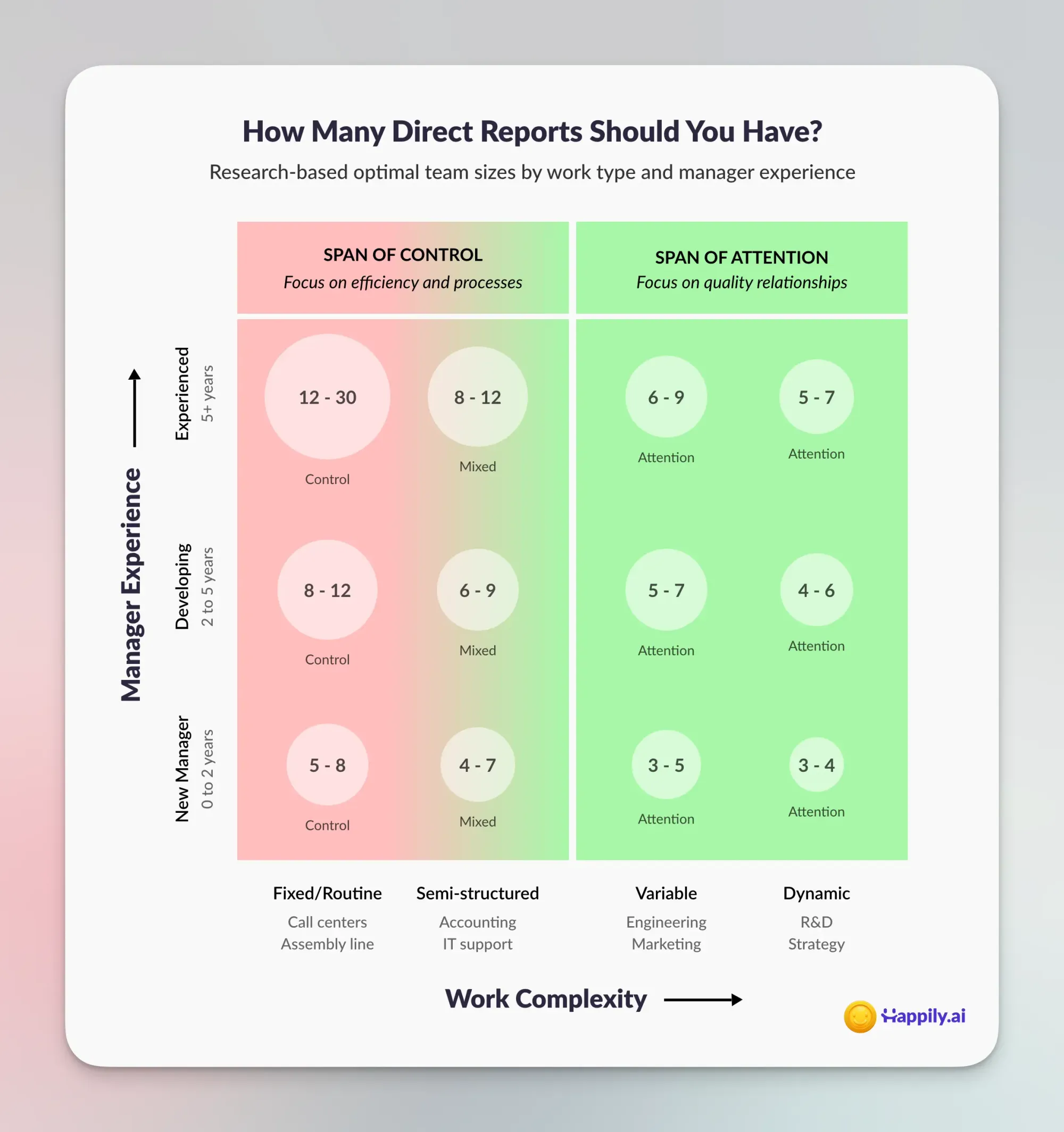A research-based framework for optimizing management spans based on cognitive limits and work complexity
Introduction
How many direct reports should a manager actually have? It's one of the most frequently asked questions in organizational design, yet most companies approach it with outdated assumptions and arbitrary rules of thumb.
After analyzing management effectiveness across 200+ companies and tracking manager performance patterns through our platform at Happily.ai, we've discovered that the answer isn't a magic number. If there was one universal answer, it would be close to 6 or 7 direct reports. But the reality is more nuanced—it's a formula based on cognitive limits, work complexity, and manager experience that most organizations completely ignore.
The cost of getting this wrong is substantial. Organizations with poorly designed management spans see 40% higher turnover, 23% slower project delivery, and managers who burn out trying to provide meaningful development to too many people. Meanwhile, companies that optimize spans based on cognitive science and work requirements consistently outperform their peers.
Quick Answer & Factors (TL;DR)
Short answer: Most managers work best with 4–8 direct reports; experienced leaders in standardized work can stretch to 6–9. There isn’t one magic number—the right span depends on:
- Work type: standardized (wider) vs. creative/ambiguous (narrower)
- Team maturity: new teams need more attention
- Manager experience: new (3–5), developing (5–7), experienced (6–9)
- Systems & support: data, workflows, and clear processes allow wider spans
Use the Attention Formula below to adjust up/down from a base of 4–5 meaningful coaching relationships.
The Evolution of Management Spans
Management spans have evolved dramatically over the past century, driven by changing work complexity, technological capabilities, and economic pressures.
Historical Context
In the early 20th century, management theorists advocated for narrow spans of control, based on the belief that managers needed close oversight of standardized industrial work. This approach dominated organizational design for decades, creating hierarchical structures with many management layers.
The 1980s brought significant change. Corporate delayering initiatives, driven by competitive pressures and new information technologies, dramatically expanded management spans. The logic was compelling: fewer management layers meant faster decision-making and lower costs.
The Modern Reality
Today's management spans tell a different story. Recent research shows:
- Average spans have doubled from 5-7 in 2000 to 10-15 today across knowledge industries
- CEO spans have expanded from approximately 5 direct reports in the 1980s to 10-14 currently (Guadalupe et al., 2014)
- Technology companies lead the trend with some organizations pushing spans to 15-20 reports per manager
This expansion occurred while work complexity increased exponentially. Modern managers handle more dynamic projects, distributed teams, and ambiguous problems than their predecessors—yet supervise twice as many people.
The Cognitive Science of Management Capacity
Understanding optimal management spans requires examining the cognitive constraints that govern human attention and relationship management.
Working Memory Limits
George Miller's seminal research on working memory established that humans can effectively process 7±2 pieces of information simultaneously (Miller, 1956). This constraint extends beyond information processing to relationship management. More recent research by Nelson Cowan suggests the actual limit may be closer to 4±1 for complex, meaningful relationships (Cowan, 2001).
These cognitive limits have profound implications for management effectiveness. Each direct report represents not just a person to supervise, but a complex system of:
- Individual motivations, strengths, and development needs
- Project contexts and deliverables
- Interpersonal dynamics and team relationships
- Performance patterns and growth trajectories
Attention as a Finite Resource
Microsoft's groundbreaking study of 61,000 employees revealed that managers don't fail because they have too many people—they fail because they run out of attention (Yang et al., 2022). The research tracked collaboration patterns and found that as spans increased, the quality of managerial relationships decreased exponentially, not linearly.
This finding aligns with attention research in cognitive psychology. Unlike financial resources, attention cannot be increased through additional investment—it can only be allocated more strategically. Managers operating beyond their cognitive capacity experience:
- Decision fatigue leading to lower-quality choices throughout the day
- Context switching costs reducing efficiency when moving between different team members' needs
- Relationship deterioration as superficial check-ins replace meaningful development conversations
- Strategic myopia as tactical demands crowd out long-term thinking
The Two Modes Framework: Span of Control vs. Span of Attention
Most organizations operate without recognizing they're playing two fundamentally different management games that require different approaches to span optimization.
Mode 1: Span of Control
The span of control model optimizes for efficiency and process management. It assumes that management is primarily about task coordination, monitoring outputs, and ensuring compliance with established procedures.
When span of control works:
- Work is highly standardized with documented processes
- Output quality is easily measured and mistakes have low consequences
- Team members require minimal individual development or coaching
- Coordination needs are predictable and routine
Examples: Call centers, manufacturing assembly lines, retail operations, data entry teams
Optimal spans: 8-15 direct reports, depending on process sophistication and team experience
Organizations like Amazon's fulfillment centers successfully operate with wide spans because the work is standardized, technology provides real-time performance data, and manager roles focus on process optimization rather than individual development.
Mode 2: Span of Attention
The span of attention model optimizes for relationship quality and human development. It recognizes that management in knowledge work is primarily about coaching, strategic thinking, and creating conditions for team members to do their best work.
When span of attention is critical:
- Work requires creativity, innovation, or complex problem-solving
- Problems are ambiguous with multiple potential solutions
- Individual development and talent retention drive competitive advantage
- High-stakes decisions require contextual judgment rather than rule-following
Examples: Software development, research and development, consulting, strategic marketing, executive leadership
Optimal spans: 4-8 direct reports, depending on work complexity and manager experience
Companies like Netflix have discovered that their most effective engineering managers handle 6-8 direct reports, allowing sufficient time for technical mentoring, career development, and strategic collaboration.
The Critical Mistake
The fundamental error most organizations make is operating in Mode 2 (knowledge work requiring attention) while keeping score with Mode 1 rules (counting heads and optimizing for span efficiency).
This mismatch creates a cascade of problems:
- Managers feel overwhelmed trying to provide meaningful development to too many people
- Team members receive superficial supervision rather than coaching
- Innovation slows as managers lack time for strategic thinking
- Turnover increases among high performers who value development and mentorship
The Attention Formula: A Practical Framework
Based on cognitive research and analysis of high-performing management teams, we've developed a practical framework for determining optimal spans.

Base Capacity: 4-5 Direct Reports
Human cognitive capacity for meaningful, developmental relationships appears to center around 4-5 people. This base capacity reflects the mental resources required to:
- Understand each individual's motivations, strengths, and development needs
- Provide timely, contextual coaching and feedback
- Make informed decisions about project assignments and career progression
- Maintain trust through consistent, high-quality interactions
Adjustment Factors
From this base, spans can be adjusted based on situational factors:
Add 1-2 reports if:
- Work is standardized with clear processes and success metrics
- Teams are experienced (3+ years working together) with established workflows
- Strong self-management culture exists with high autonomy and accountability
- Robust systems support provides real-time performance data and decision support
- Low geographic complexity with co-located or well-coordinated distributed teams
Subtract 1-2 reports if:
- Work requires innovation with ambiguous problems and creative solutions
- Team members are new to role, company, or industry requiring intensive development
- High-stakes decisions are frequent with significant consequences for errors
- Complex coordination is required across multiple stakeholders or time zones
- Manager is new to leadership role or learning new domain expertise
Manager Experience Considerations
The framework also accounts for management experience and capability:
New Managers (0-2 years): Should start with 3-5 reports to develop coaching skills and establish credibility without becoming overwhelmed.
Developing Managers (2-5 years): Can handle 5-7 reports as they refine their management approach and build systems for effective team leadership.
Experienced Managers (5+ years): May effectively manage 6-9 reports, depending on work complexity and organizational support systems.
Industry Applications and Case Studies
The attention formula produces different optimal spans across industries and roles, reflecting varying work complexity and coordination requirements.
Technology Sector
Software Engineering Teams:
- Senior engineers: 4-6 reports (high technical mentoring requirements)
- Product managers: 5-8 reports (cross-functional coordination complexity)
- Engineering directors: 6-9 reports (experienced team leads as direct reports)
Case Study - Netflix: Engineering management spans of 6-8 reports allow for technical depth, career development, and innovation velocity. Wider spans showed decreased code quality and slower feature delivery.
Professional Services
Management Consulting:
- Project managers: 3-5 reports (high client stakes, complex problem-solving)
- Practice leaders: 5-7 reports (mix of client delivery and business development)
- Office managing directors: 8-12 reports (experienced partners as direct reports)
Case Study - McKinsey & Company: Partner-level managers typically oversee 6-8 engagement managers, balancing client delivery excellence with consultant development.
Healthcare Administration
Clinical Operations:
- Department heads: 4-6 reports (regulatory complexity, patient safety requirements)
- Nursing supervisors: 6-10 reports (standardized care protocols with some complexity)
- Hospital administrators: 8-12 reports (experienced department heads as direct reports)
Case Study - Cleveland Clinic: Reduced nursing supervisor spans from 12 to 8 reports, resulting in 15% improvement in patient satisfaction scores and 22% reduction in nursing turnover.
Financial Services
Investment Management:
- Portfolio managers: 3-5 reports (high-stakes decision making, regulatory requirements)
- Research directors: 5-7 reports (complex analysis, external stakeholder management)
- Regional managers: 8-12 reports (experienced team leads in standardized processes)
The Hidden Costs of Oversized Spans
When management spans exceed cognitive capacity, organizations pay hidden costs that compound over time.
Quantified Impact on Development Time
Research conducted across multiple organizations reveals a clear mathematical relationship between span size and development quality. When a manager oversees 15 people instead of 6, each team member loses approximately 2.3 hours of meaningful development time monthly.
This calculation accounts for:
- Reduced 1:1 meeting frequency (from weekly to bi-weekly or monthly)
- Shorter conversation duration as managers rush through multiple check-ins
- Decreased coaching quality as managers lack time to prepare thoughtful guidance
- Delayed feedback cycles as managers struggle to process and respond to team needs
Multiply this impact across an organization, and companies systematically impair human potential development. A 500-person company with oversized management spans loses approximately 25,000 hours of development time annually—equivalent to 12 full-time roles focused entirely on talent development.
Decision Quality Degradation
Cognitive overload doesn't just affect relationship quality—it impairs decision-making effectiveness. Managers handling too many direct reports experience:
Decision Fatigue: The quality of decisions deteriorates throughout the day as mental resources deplete (Baumeister et al., 1998). Managers making numerous daily decisions about multiple team members show measurably worse judgment on later decisions.
Information Processing Limitations: Oversized spans create information overload, leading managers to rely on simplified heuristics rather than thoughtful analysis. This results in:
- Promotion decisions based on recent performance rather than comprehensive evaluation
- Project assignments that optimize for manager convenience rather than development opportunities
- Conflict resolution that addresses symptoms rather than underlying issues
Strategic Time Displacement: Administrative overhead from managing too many relationships crowds out strategic thinking time. Research shows that managers with spans above 10 spend 65% more time in meetings and administrative tasks, leaving insufficient time for planning, innovation, and long-term team development.
Technology's Role in Span Optimization
Modern technology creates new possibilities for extending effective management spans without sacrificing relationship quality, but only when implemented thoughtfully.
AI-Powered Management Support
Artificial intelligence can handle routine management tasks, freeing managers to focus on high-value human interactions:
Automated Check-ins: AI systems can conduct regular pulse surveys, track project progress, and identify team members who need manager attention, allowing managers to focus their limited time on the most critical interactions.
Predictive Analytics: Machine learning can identify patterns in team performance, engagement, and retention risk, enabling proactive rather than reactive management interventions.
Personalized Coaching Recommendations: AI can analyze individual team member preferences, strengths, and development needs to suggest tailored coaching approaches for each person.
Digital Communication Tools
Advanced communication platforms enable more efficient coordination without sacrificing relationship depth:
Asynchronous Feedback Systems: Allow for thoughtful, documented performance conversations that don't require simultaneous availability across time zones.
Team Collaboration Platforms: Provide visibility into team dynamics and project progress without requiring constant manager monitoring.
Virtual Reality Meeting Spaces: Enable rich, face-to-face interactions for distributed teams, partially addressing the relationship quality challenges of remote management.
The Happily.ai Approach: Amplifying Manager Attention
At Happily.ai, we've designed our platform specifically to help managers maintain meaningful relationships with larger teams without exceeding their cognitive capacity. Our approach recognizes that technology should amplify human attention rather than replace it.
Intelligent Attention Allocation: Our AI identifies which team members most need manager attention at any given time, helping managers prioritize their limited cognitive resources on the highest-impact interactions.
Automated Relationship Maintenance: The platform handles routine check-ins, progress tracking, and basic feedback collection, ensuring no team member feels neglected while preserving manager bandwidth for complex coaching conversations.
Predictive Development Insights: Machine learning analyzes team member patterns to predict development needs, career interests, and potential challenges before they become problems, enabling proactive rather than reactive management.
Real-time Span Optimization: The platform continuously monitors manager workload and effectiveness, providing recommendations for span adjustments based on actual performance data rather than arbitrary rules.
Organizations using Happily.ai report the ability to maintain high-quality relationships with 20-30% larger teams while actually reducing manager stress and improving team outcomes.
FAQs
- Q: Is there a universal “best” number of direct reports?
A: No. Start from 4–5 and adjust for work complexity, team maturity, systems, and manager experience. - Q: When can spans go above 8–9?
A: When work is standardized, teams are experienced, and data/systems reduce coaching load. - Q: What are signs your span is too wide?
A: Fewer/shorter 1:1s, slower development, rising rework/turnover, and manager burnout.
Implementation: Moving from Theory to Practice
Successfully optimizing management spans requires a systematic approach that accounts for organizational culture, existing structures, and change management realities.
Assessment Phase
Current State Analysis: Begin by mapping existing spans across the organization, identifying which roles operate in control vs. attention modes, and measuring current management effectiveness through team engagement, development velocity, and retention metrics.
Work Complexity Evaluation: Categorize roles based on standardization level, decision complexity, and coordination requirements. Use the framework to determine theoretical optimal spans for each category.
Manager Capability Assessment: Evaluate current managers' experience levels, coaching skills, and capacity for handling different span sizes. Identify development needs and succession planning requirements.
Pilot Implementation
Select Test Groups: Choose 2-3 management teams representing different work types (standardized vs. creative) and span challenges (oversized vs. appropriately sized) for controlled experimentation.
Measure Baseline Metrics: Establish baseline measurements for team engagement, development time, decision quality, manager satisfaction, and business outcomes before making changes.
Implement Gradual Adjustments: Make span changes gradually over 3-6 months, allowing time for new relationship patterns to develop and managers to adjust their approaches.
Scaling and Optimization
Monitor Leading Indicators: Track early signals of success or problems: 1:1 meeting quality, feedback frequency, team member satisfaction with development opportunities, and manager stress levels.
Adjust Based on Results: Use data to refine span targets for different roles, identify manager development needs, and optimize support systems.
Cultural Integration: Embed attention-based management principles into hiring, promotion, and performance evaluation processes to sustain the changes over time.
Measuring Success: Key Performance Indicators
Effective span optimization requires measuring both manager effectiveness and team outcomes.
Manager-Level Metrics
Attention Quality Indicators:
- Average time spent in meaningful development conversations per team member
- Frequency and depth of coaching interactions
- Manager-reported stress and job satisfaction levels
- Time allocation between administrative tasks and strategic work
Relationship Quality Measures:
- Team member ratings of manager support and development
- Trust and psychological safety scores within teams
- Frequency of proactive vs. reactive manager interventions
Team-Level Outcomes
Development Velocity:
- Skill advancement rates among team members
- Internal promotion rates and career progression speed
- Knowledge sharing and cross-training effectiveness
Performance Indicators:
- Project delivery speed and quality
- Innovation metrics and creative output
- Customer satisfaction with team outputs
Retention and Engagement:
- Voluntary turnover rates among high performers
- Employee Net Promoter Score (eNPS) at team level
- Participation in discretionary activities and initiatives
Organizational Impact
Strategic Outcomes:
- Decision-making speed at multiple organizational levels
- Adaptability and response time to market changes
- Leadership pipeline strength and succession readiness
Financial Performance:
- Revenue per employee in knowledge worker roles
- Cost savings from reduced turnover and faster development
- Return on investment in management development programs
The Future of Management Spans
Several trends will shape how organizations approach span optimization in the coming decade.
Remote and Hybrid Work Evolution
The shift to distributed work creates new challenges and opportunities for management spans. Remote work can enable wider spans by reducing interruptions and providing digital tools for coordination, but it also increases the effort required to maintain relationship quality and team cohesion.
Emerging Best Practices:
- Hybrid managers effectively handle 15-20% larger spans than historical norms when supported by appropriate technology
- Synchronous relationship-building time becomes more valuable and must be protected
- Asynchronous work coordination enables attention focus on high-value human interactions
Artificial Intelligence Integration
AI will increasingly handle routine management tasks, potentially enabling larger effective spans without sacrificing relationship quality. However, this requires careful implementation to enhance rather than replace human connection.
Technology Amplification:
- AI-powered coaching suggestions help managers provide more effective development guidance
- Predictive analytics identify team members who need attention before problems escalate
- Automated administrative tasks free manager cognitive capacity for strategic work
Generational Workforce Changes
Generation Z employees entering the workforce have different expectations for manager relationships, development opportunities, and autonomy levels. These preferences will influence optimal span design.
Shifting Expectations:
- Higher demand for frequent feedback and development conversations
- Greater comfort with AI-mediated interactions for routine check-ins
- Stronger preference for manager authenticity over authority-based relationships
Conclusion: Manager Attention as Strategic Advantage
The question of optimal management spans ultimately comes down to recognizing manager attention as your organization's scarcest and most strategic resource. Unlike financial capital, attention cannot be increased through additional investment—it can only be allocated more wisely.
Organizations that optimize spans based on cognitive science, work complexity, and relationship requirements will consistently outperform those that rely on arbitrary rules or historical precedent. The competitive advantage is substantial: better decisions, faster development, higher retention, and managers who thrive rather than burn out.
The framework is clear:
- Identify your management mode (control vs. attention) based on work requirements
- Apply the attention formula with appropriate adjustments for context
- Measure and optimize based on relationship quality and team outcomes
- Leverage technology to amplify rather than replace human connection
The cost of getting this wrong—oversized spans that exceed cognitive capacity—compounds over time through reduced development quality, impaired decision-making, and management burnout. The benefit of optimization is immediate and sustainable: teams that perform at their highest level while developing the capabilities needed for future success.
Manager attention is your limiting resource. Organizations that allocate it wisely will build the management capability that drives long-term competitive advantage.
Ready to optimize your management spans and amplify manager effectiveness? Happily.ai provides the tools and insights needed to implement attention-based management at scale. Our platform helps managers maintain high-quality relationships with larger teams while reducing stress and improving outcomes. Learn more about how leading companies are revolutionizing their management approach.
References
Child, J., & McGrath, R. G. (2001). Organizations unfettered: Organizational form in an information-intensive economy. Academy of Management Journal, 44(6), 1135-1148.
Cowan, N. (2001). The magical number 4 in short-term memory: A reconsideration of mental storage capacity. Behavioral and Brain Sciences, 24(1), 87-114.
Guadalupe, M., Li, H., & Wulf, J. (2014). Who lives in the C-suite? Organizational structure and the division of labor in top management. Management Science, 60(4), 824-844.
Miller, G. A. (1956). The magical number seven, plus or minus two: Some limits on our capacity for processing information. Psychological Review, 63(2), 81-97.
Yang, L., Holtz, D., Jaffe, S., Suri, S., Sinha, S., Weston, J., ... & Teevan, J. (2022). The effects of remote work on collaboration among information workers. Nature Human Behaviour, 6(1), 43-54.









